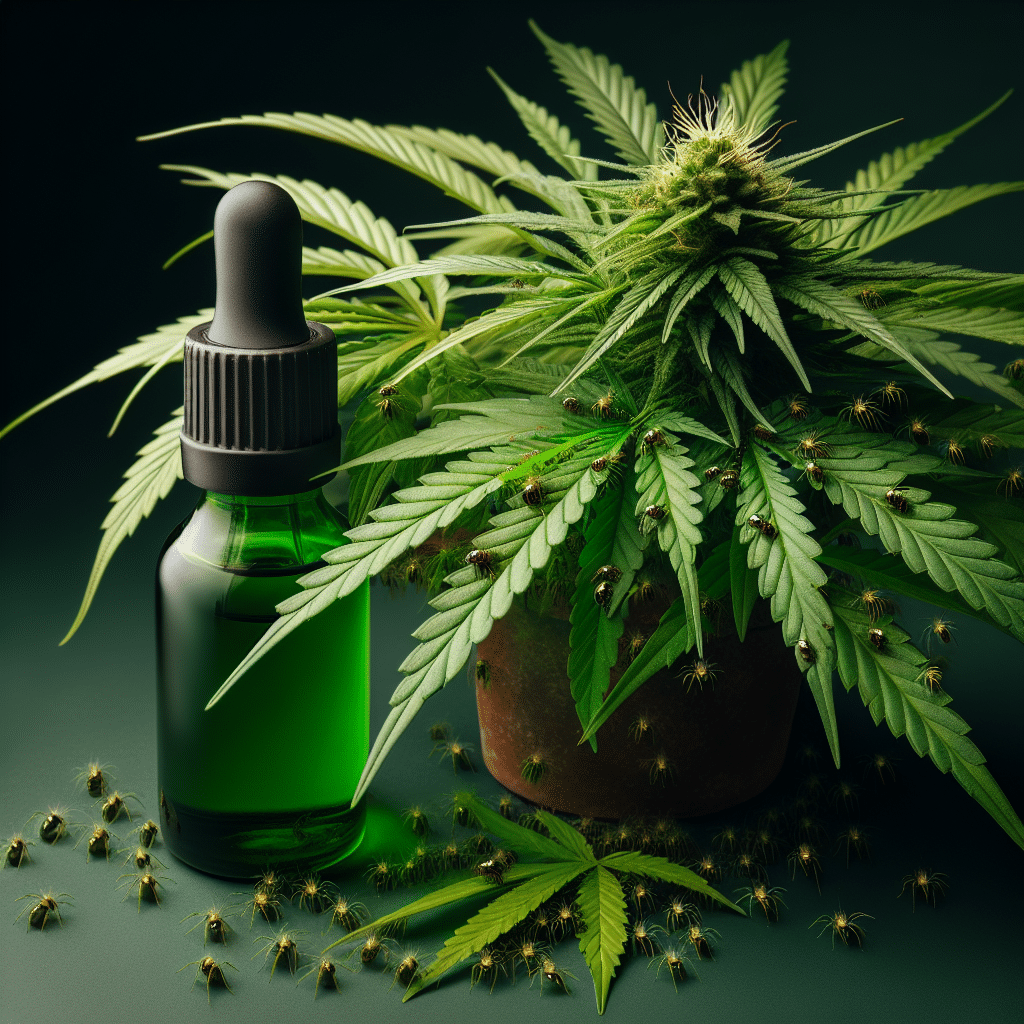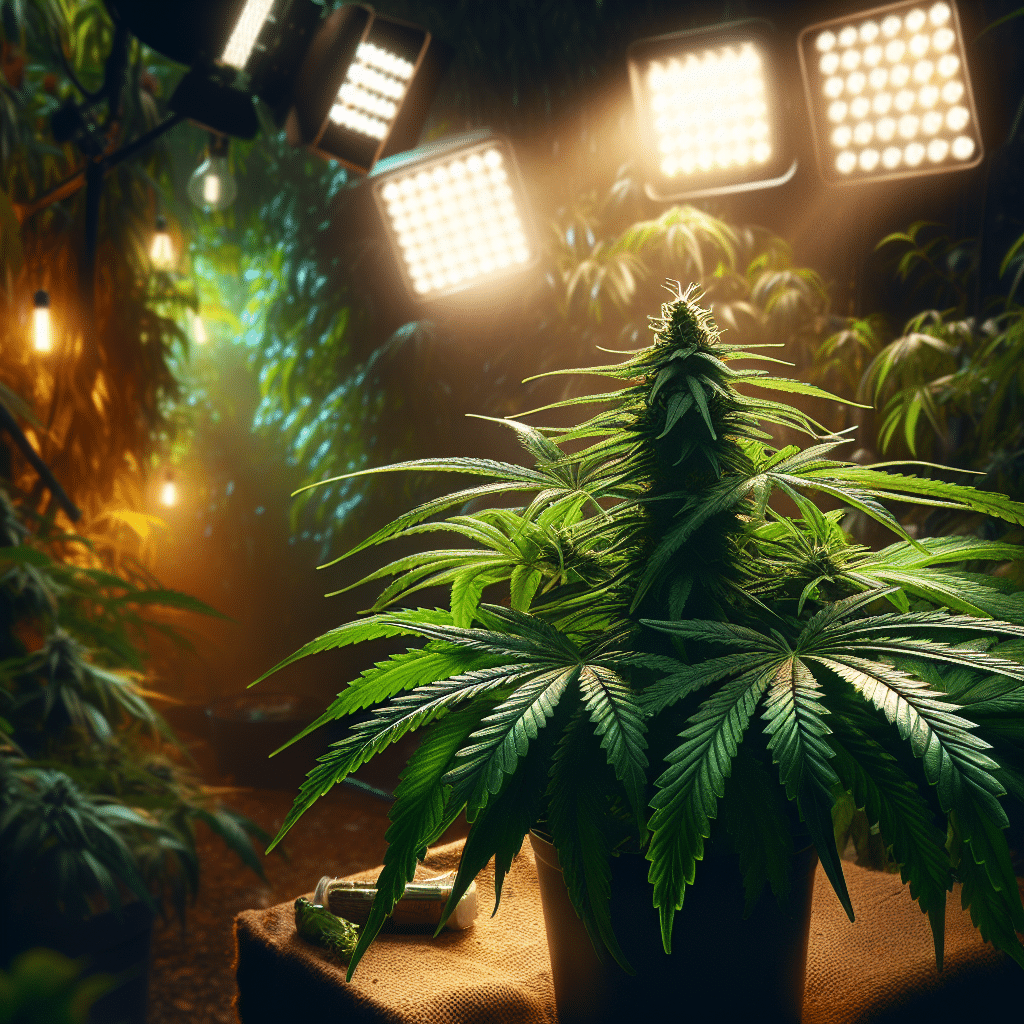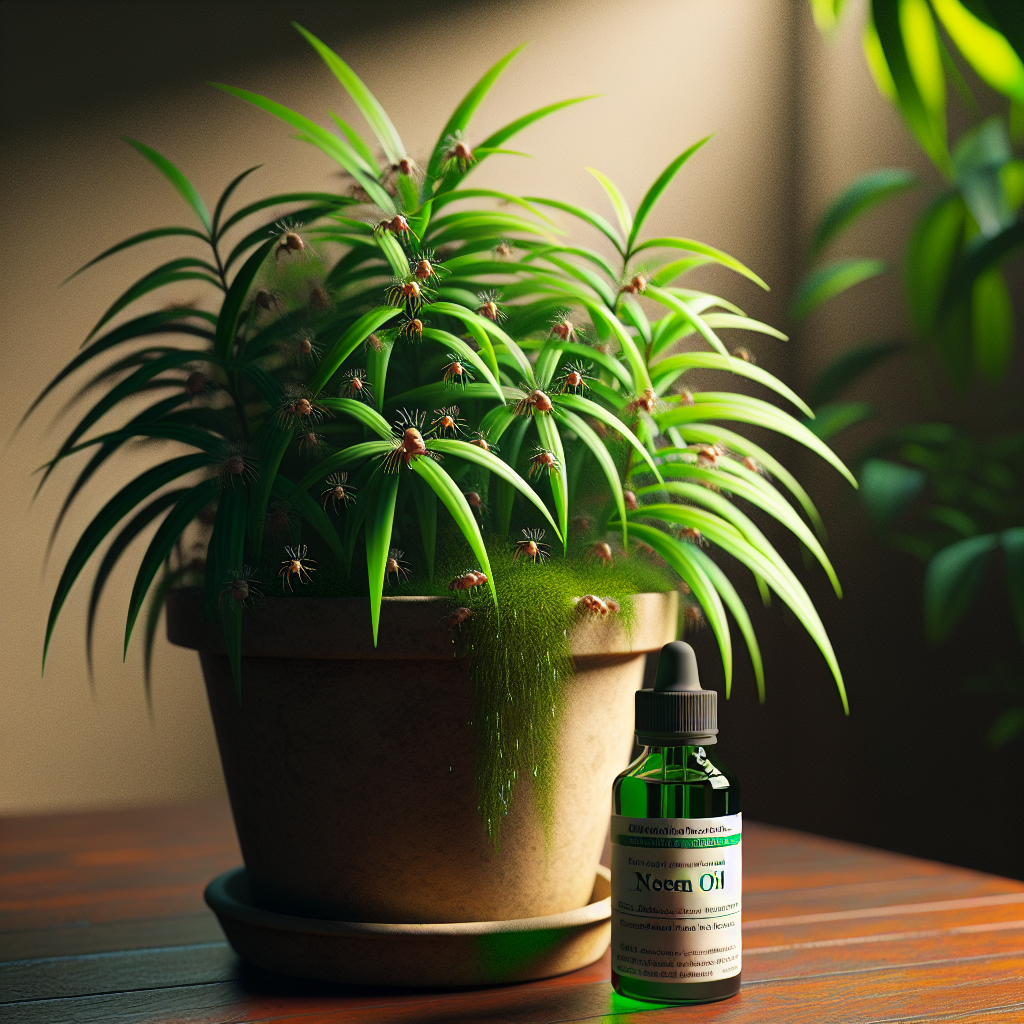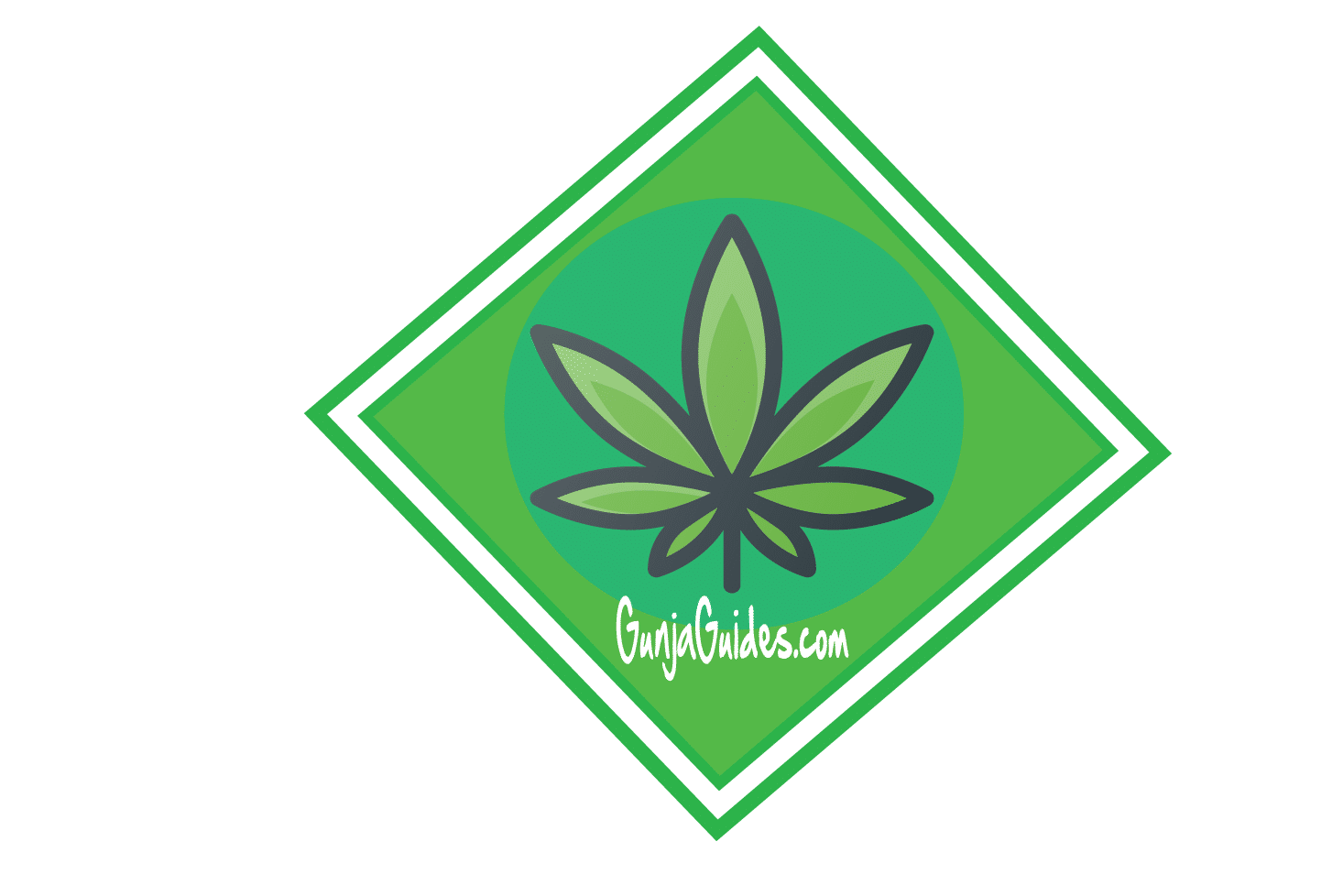Mastering Neem Oil for Cannabis Pest Control: An In-Depth Guide

Mastering Neem Oil for Cannabis Pest Control: An In-Depth Guid
Introduction:
Cannabis cultivation presents unique challenges, particularly when it comes to pest control. Neem oil has emerged as a popular organic solution due to its multifaceted benefits and effectiveness against various pests. This guide delves into the origins and extraction of neem oil, its mechanisms of action, application methods for different growth stages, safety precautions, situations to avoid using it on cannabis plants, and explores alternative organic pesticides.
1. Understanding Neem Oil: Origins and Extraction
Neem oil, derived from the seeds of the neem tree (Azadirachta indica), has been used for centuries in traditional medicine and agriculture due to its potent bioactive compounds. The neem tree is native to the Indian subcontinent but can also be found in various tropical and subtropical regions around the world.
The extraction process of neem oil begins with harvesting ripe neem fruits, which are then cleaned and de-pulped to obtain the seeds. These seeds contain kernels that are rich in oil. There are several methods for extracting this valuable oil:
1. Cold Pressing: This is one of the most common methods used to extract high-quality neem oil. In cold pressing, neem seeds are mechanically pressed at low temperatures to release their oils without altering their chemical composition or beneficial properties. Cold-pressed neem oil retains a higher concentration of active ingredients like azadirachtin, nimbin, and salannin.
2. Solvent Extraction: Another method involves using solvents such as hexane to dissolve the oils from crushed neem seeds or kernels. While this method can yield more oil compared to cold pressing, it may also introduce solvent residues into the final product if not properly refined.
3. Steam Distillation: Although less common for extracting pure neem seed oil, steam distillation is often employed when producing essential oils from other parts of the plant like leaves or bark.
4. Aqueous Extraction: In some cases where traditional techniques are preferred over modern machinery-based processes – especially within rural communities – aqueous extraction might be utilized by soaking ground-up kernels in water before filtering out impurities through cloth sieves followed by boiling down liquid extracts until only concentrated oily substances remain behind after evaporation occurs naturally under sunlight exposure conditions over time periods ranging anywhere between several days up towards weeks depending upon ambient weather factors influencing drying rates accordingly too!

2. How Neem Oil Affects Pests
Neem oil, derived from the seeds of the neem tree (Azadirachta indica), is a potent organic pesticide widely used in cannabis cultivation for its multifaceted mechanisms of action against pests. Understanding these mechanisms can help growers utilize neem oil more effectively and sustainably.
One of the primary active compounds in neem oil is azadirachtin, which disrupts the hormonal systems of insects. Azadirachtin interferes with the molting process by inhibiting ecdysone, an essential hormone for insect development. When pests ingest or come into contact with azadirachtin, they are unable to progress through their life stages properly. This disruption leads to incomplete molts and ultimately results in death or severe developmental issues that prevent reproduction.
In addition to disrupting growth hormones, neem oil acts as an antifeedant. The presence of azadirachtin makes plant tissues unpalatable to many herbivorous insects such as aphids, spider mites, and whiteflies. When these pests encounter treated plants, they tend to avoid feeding on them due to the bitter taste and adverse effects on their digestive systems. This reduction in feeding activity helps protect cannabis plants from extensive damage while allowing beneficial insects like pollinators and predators to thrive.
Neem oil also exhibits repellent properties that deter pests from laying eggs on treated surfaces. Compounds such as salannin and nimbin contribute to this repellent effect by creating an inhospitable environment for egg-laying females. By reducing oviposition rates, neem oil helps break pest life cycles over time, leading to a gradual decline in population levels within a grow area.
Another significant mechanism involves neem oil’s ability to inhibit fungal spore germination and mycelial growth. Many common cannabis pathogens like powdery mildew and botrytis are susceptible to neem’s antifungal properties. By applying neem oil regularly during vulnerable periods—such as high humidity conditions—growers can reduce fungal infections’ incidence and severity without resorting to synthetic fungicides.
Moreover, neem oil contains limonoids that exhibit systemic properties when absorbed by plant tissues through foliar sprays or soil drenches. These limonoids circulate within the plant’s vascular system providing internal protection against sap-sucking insects like thrips or leafhoppers who might otherwise escape surface treatments alone.
It’s important not only how but when you apply it; timing plays crucial role too! For instance early morning hours before sun rises fully ensures maximum absorption minimizing phototoxicity risks associated prolonged exposure sunlight post-application especially sensitive young leaves new shoots developing buds etcetera thus optimizing efficacy overall pest management strategy employed throughout entire growing season ensuring healthy robust yields free harmful residues detrimental both consumer health environmental sustainability alike!
In summary understanding intricate ways which various constituents present naturally occurring botanical extract work synergistically together target multiple aspects insect physiology behavior simultaneously offers invaluable insights enabling informed decisions regarding integrated pest management practices tailored specifically needs individual cultivator preferences constraints unique circumstances faced each specific cultivation scenario encountered along journey mastering art science successful sustainable organic cannabis production utilizing versatile powerful tool known simply yet profoundly effective safe environmentally friendly alternative conventional chemical pesticides – none other than humble mighty ‘neem’ itself!

3. Step-by-Step Usage Instructions for Different Growth Stages
Using neem oil effectively requires understanding the specific needs of cannabis plants at various growth stages. Each stage—seedling, vegetative, and flowering—demands tailored application techniques to maximize pest control while minimizing potential harm to the plant.
Seedling Stage:
At this delicate phase, seedlings are particularly vulnerable to pests like aphids and spider mites. However, they are also sensitive to strong treatments. To use neem oil safely:
1. **Dilution:** Mix 0.5 teaspoons of neem oil with one quart of water and add a few drops of mild liquid soap as an emulsifier.
2. **Application:** Use a fine mist spray bottle to apply the solution lightly on the leaves’ surface once every two weeks.
3. **Timing:** Apply in the early morning or late evening when temperatures are cooler and light intensity is lower to prevent leaf burn.
Vegetative Stage:
During this period, cannabis plants grow rapidly and can handle more robust treatments compared to seedlings.
1. Dilution: Increase concentration slightly by mixing 1 teaspoon of neem oil per quart of water with a few drops of liquid soap.
2. Application Frequency: Spray both sides of the leaves thoroughly once a week.
3. Coverage: Ensure even coverage but avoid drenching; excess moisture can lead to mold or mildew issues.
4. Timing: Continue applying during cooler parts of the day—early morning or late evening—to reduce stress on plants.
Flowering Stage:
This stage is critical because improper application can affect bud quality and taste due to residual oils.
1. Dilution Adjustment: Maintain a low concentration (0.5 teaspoons per quart) similar to that used in the seedling stage.
2. Spot Treatment Only: Focus on areas showing signs of infestation rather than spraying entire plants.
3. Frequency Reduction: Limit applications to once every three weeks unless there’s severe pest pressure.
4. Pre-Harvest Interval (PHI): Cease all neem oil applications at least two weeks before harvest time to ensure no residues remain on buds.
By adhering closely to these step-by-step instructions tailored for each growth stage, you can effectively manage pests without compromising your cannabis plants’ health or yield quality
4. Effective Application Methods: Foliar Spray vs Soil Drench
When it comes to using neem oil for cannabis pest control, understanding the most effective application methods is crucial. Two primary techniques are commonly employed: foliar spray and soil drench. Each method has its own set of advantages and specific use cases, making it essential to know when and how to apply them for optimal results.
Foliar Spray
Foliar spraying involves applying a diluted neem oil solution directly onto the leaves of the cannabis plant. This method is particularly effective against pests that reside on or feed off the foliage, such as spider mites, aphids, and whiteflies.
1. Preparation: To prepare a foliar spray, mix 1-2 teaspoons of cold-pressed neem oil with one quart (approximately one liter) of water. Add a few drops of mild liquid soap as an emulsifier to help the oil mix thoroughly with water.
2. Application: Use a fine mist sprayer to apply the solution evenly across all leaf surfaces, including the undersides where pests often hide. It’s best to perform this task during early morning or late evening hours when temperatures are cooler and sunlight is less intense, reducing the risk of leaf burn.
3. Frequency: For preventive measures, apply every 7-14 days throughout the growing season. If dealing with an active infestation, increase frequency to every 5-7 days until pest numbers decline.
4. Advantages:
– Direct contact ensures immediate action against visible pests.
– Can be used as both a curative and preventive measure.
– Helps in controlling fungal issues like powdery mildew due to its antifungal properties.
5. Considerations:
– Avoid spraying during peak sunlight hours or high temperatures as this can cause phytotoxicity (leaf burn).
– Ensure thorough coverage but avoid over-saturation which can lead to mold growth.
Soil Drench
A soil drench involves watering plants with a diluted neem oil solution so that it gets absorbed by roots and translocated throughout the plant’s vascular system. This method targets soil-dwelling pests like fungus gnats and root aphids while also providing systemic protection against some above-ground insects.
1. Preparation: Mix 1 teaspoon of cold-pressed neem oil per gallon (approximately four liters) of water along with a few drops of mild liquid soap as an emulsifier.
2. Application: Water your cannabis plants with this mixture at their base until you see runoff from drainage holes in pots or containers.
3. Frequency: Apply once every three weeks during regular watering schedules for ongoing protection; more frequent applications may be necessary if battling severe infestations.
4. Advantages:
– Provides systemic protection by allowing plants to absorb azadirachtin (the active compound in neem oil), which deters feeding insects from within.
– Targets soil-borne pests effectively without disrupting beneficial insect populations on foliage.
5. Considerations:
– Overuse can potentially affect beneficial microorganisms in soil; balance usage accordingly.
– Less immediate impact compared to foliar sprays since absorption takes time before effects manifest on above-ground parts.
In summary, both foliar spray and soil drench methods offer unique benefits tailored towards different types of pest challenges faced by cannabis growers using neem oil treatments effectively requires understanding these distinctions ensuring healthier robust crops free from harmful infestations organically sustainably
5. Essential Safety Precautions When Handling Neem Oil
When it comes to using neem oil for cannabis pest control, safety should be a top priority. While neem oil is generally considered safe and organic, improper handling can lead to unintended consequences for both the plants and the person applying it. Here are some essential safety precautions to keep in mind:
Personal Protective Equipment (PPE)
First and foremost, always wear appropriate personal protective equipment (PPE) when handling neem oil. This includes gloves, long sleeves, eye protection, and possibly a mask if you are sensitive to strong odors or have respiratory issues. Neem oil can cause skin irritation or allergic reactions in some individuals, so it’s crucial to minimize direct contact.
Proper Dilution
Neem oil is highly concentrated and must be diluted before application. Always follow the manufacturer’s guidelines for dilution rates. Using undiluted neem oil can harm your cannabis plants by causing leaf burn or other phytotoxic effects. Typically, a mixture of 1-2 tablespoons of neem oil per gallon of water is recommended.
Avoid Inhalation
While spraying neem oil solutions, avoid inhaling the mist as much as possible. Even though it’s an organic product, inhaling any kind of pesticide spray can irritate your respiratory system. If you’re working in an enclosed space like a greenhouse or grow tent, ensure adequate ventilation.
Storage Conditions
Store neem oil in a cool, dark place away from direct sunlight and out of reach of children and pets. Exposure to light and heat can degrade its effectiveness over time. Make sure that containers are tightly sealed to prevent leaks or spills.
Timing of Application
Apply neem oil during early morning or late evening hours when temperatures are cooler and there is less direct sunlight on the plants. High temperatures combined with sunlight can enhance the risk of leaf burn due to increased sensitivity after application.
Test Before Full Application
Before applying neem oil solution broadly across all your cannabis plants, conduct a patch test on a small section first—preferably on one plant—to observe any adverse reactions over 24-48 hours. This step helps ensure that your specific strain does not react negatively to the treatment.
Environmental Considerations
Be mindful of where you apply neem oil; avoid spraying near water sources such as ponds or streams since runoff could affect aquatic life despite its low toxicity levels compared to synthetic pesticides.
Disposal Guidelines
Dispose of empty containers responsibly according to local regulations for hazardous waste disposal rather than throwing them into regular trash bins where they might pose risks later on.
By adhering strictly to these safety precautions while handling neem oil for cannabis pest control purposes will help ensure not only effective pest management but also safeguard both human health and environmental integrity.
6. Situations to Avoid Using Neem Oil on Cannabis Plants
While neem oil is a versatile and effective organic pesticide, there are specific situations where its use can be detrimental to cannabis plants. Understanding these scenarios will help you avoid potential pitfalls and ensure the health and productivity of your crop.
1. During Flowering Stage:
One of the most critical times to avoid using neem oil is during the flowering stage of cannabis growth. Applying neem oil at this stage can lead to several issues:
– Taste and Aroma Contamination: Neem oil has a strong odor that can permeate the buds, negatively affecting their taste and aroma.
– Residue Build-Up: The sticky nature of neem oil can leave residues on flowers, which may not fully wash off even after harvest, leading to an unpleasant smoking experience.
– Potential Health Risks: Inhaling or ingesting residual neem oil from treated buds could pose health risks.
2. Under Direct Sunlight:
Applying neem oil when your cannabis plants are exposed to direct sunlight should be avoided due to the risk of phototoxicity:
– Leaf Burn: Neem oil combined with intense sunlight can cause leaf burn or scorch marks, damaging plant tissues.
– Reduced Efficacy: High temperatures may degrade some active compounds in neem oil, reducing its effectiveness against pests.
**3. During Extreme Temperature Conditions:
Extreme temperatures—either too hot or too cold—can impact both the efficacy of neem oil and the well-being of your plants:
– **Heat Stress:** High temperatures (above 85°F) can exacerbate phytotoxic effects, causing stress or damage to leaves.
– **Cold Ineffectiveness:** Conversely, applying neem oil in very cold conditions (below 40°F) might reduce its pest control capabilities as it becomes less effective at lower temperatures.
4. On Stressed Plants:
Avoid using neem oil on plants that are already stressed due to factors such as overwatering, nutrient deficiencies, or physical damage:
– Compounding Stress Factors: Introducing another stressor like a pesticide could worsen existing problems rather than alleviate them.
– Delayed Recovery: Stressed plants have weakened defenses; adding chemical treatments might delay their recovery process further.
5. With Certain Beneficial Insects Present:
Neem oil does not discriminate between harmful pests and beneficial insects like ladybugs or predatory mites:
– Disruption of Ecosystem Balance: Overuse can disrupt natural predator-prey relationships within your garden ecosystem.
– Secondary Pest Outbreaks: Killing off beneficial insects may inadvertently lead to secondary pest outbreaks by removing natural controls.
6. Close Proximity To Harvest Time:
Using neem oil close to harvest time is generally discouraged for several reasons:
– Residual Presence in Buds: Even if applied sparingly, traces might remain on harvested buds affecting quality.
– Regulatory Compliance Issues: Some regions have strict regulations regarding pesticide residues; non-compliance could result in legal ramifications.
In summary, while neem oil is an excellent tool for managing pests organically in cannabis cultivation, careful consideration must be given regarding when and how it’s used. By avoiding application during flowering stages, under direct sunlight or extreme temperature conditions, on stressed plants or near harvest time—and being mindful about preserving beneficial insect populations—you’ll maximize benefits while minimizing potential drawbacks associated with this potent natural remedy.
7. Exploring Alternative Organic Pesticides for Cannabis Cultivation
While neem oil is a highly effective and popular choice for organic pest control in cannabis cultivation, it’s not the only option available to growers seeking environmentally friendly solutions. Diversifying your pest management strategy can help prevent resistance buildup and ensure comprehensive protection against a variety of pests. Here are some alternative organic pesticides that you might consider:
1. Diatomaceous Earth (DE):
Diatomaceous earth is a natural powder made from fossilized remains of diatoms, a type of hard-shelled algae. It works by physically damaging the exoskeletons of insects, leading to dehydration and death. DE is particularly effective against soft-bodied insects like aphids, thrips, and spider mites.
To use DE:
– Dust it lightly on the leaves and soil surface.
– Reapply after watering or rain as it loses effectiveness when wet.
– Use caution to avoid inhaling the fine particles.
2. Insecticidal Soaps:
Insecticidal soaps are potassium salts of fatty acids that disrupt the cell membranes of insects upon contact, causing them to dehydrate and die. These soaps are especially useful against soft-bodied pests such as aphids, whiteflies, mealybugs, and spider mites.
To apply insecticidal soap:
– Mix according to label instructions.
– Spray directly onto affected plants ensuring thorough coverage.
– Repeat applications every 5–7 days until pests are controlled.
3. Pyrethrin:
Pyrethrin is derived from chrysanthemum flowers and acts as a neurotoxin affecting the nervous system of insects upon contact or ingestion. It’s effective against a wide range of pests including beetles, caterpillars, leafhoppers, aphids, and more.
When using pyrethrin:
– Follow label directions carefully for dilution rates.
– Apply during early morning or late evening to minimize impact on beneficial insects like bees.
– Be aware that overuse can lead to pest resistance.
4. Bacillus thuringiensis (Bt):
Bt is a naturally occurring bacterium that produces toxins harmful specifically to certain insect larvae such as caterpillars but safe for humans and other animals. Different strains target different types of pests; Bt kurstaki targets caterpillars while Bt israelensis targets mosquito larvae.
For Bt application:
– Select the appropriate strain based on targeted pest species.
– Mix with water according to product instructions.
– Spray onto foliage where larvae feed; reapply after rain or heavy dew.
5. Horticultural Oils:
These oils work by smothering insect eggs and immature stages rather than killing adult insects outright. They’re particularly useful in controlling scale insects, spider mites, whiteflies among others without leaving toxic residues behind.
Using horticultural oils involves:
-Mixing with water per manufacturer’s guidelines
-Spraying thoroughly covering all plant surfaces
-Avoiding use during high temperatures which may cause phytotoxicity
6. Spinosad:
Spinosad originates from fermentation process involving specific bacteria species Saccharopolyspora spinosa producing compounds toxic primarily towards chewing-type pests like thrips,caterpillar etc.,but relatively safer towards non-target organisms including mammals,birds etc..
Application steps include :
-Diluting concentrate following package recommendations
-Applying via foliar spray focusing heavily infested areas
-Repeating treatment intervals suggested within product literature
By integrating these alternatives into your integrated pest management plan alongside neem oil,you’ll enhance overall efficacy reducing likelihood developing resistant populations thereby promoting healthier robust cannabis crops organically .
Conclusion: Mastering Neem Oil for Cannabis Pest Control: An In-Depth Guide
Mastering the use of neem oil in cannabis cultivation requires an understanding of its properties, proper application techniques tailored to each growth stage, and adherence to safety precautions. While neem oil is highly effective, knowing when not to use it is equally important for maintaining plant health and yield quality. Additionally, exploring alternative organic pesticides can provide a comprehensive approach to pest management. By integrating these practices into your cultivation routine, you can achieve robust and healthy cannabis crops organically.
In-Depth Guide Mastering Neem Oil for Cannabis Pest Cannabis neem oil for cannabis


